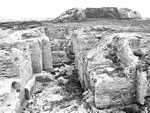 |
| source: samarkand-foto.ru |
On the outskirts of Samarkand there spread yellow-gray hills. The place is deserted, but everywhere you can see houses, remnants of walls, sites of archaeological excavations. It was here that once Samarkand was originated, and the name of this place Afrasiab.
It is located in the north of the town, and occupies 200 hectares. It is believed that the fort was the ancient capital of Sogdiana, and received its name in honor of the king of Turan, sung in a poem by Ferdowsi Persian poetry.
Archaeological excavations began here in the late XIX century, which resulted in finding monuments, women's jewelry, coins, weapons and tools, glassware, tableware and much more. Also, it has become known for sure that Afrasiab was the capital of Sogd States, and was one of the biggest trade and cultural centers of Central Asia, on the Silk Road.
The town, situated on the hills was excellent fortifications - from the east and north it was protected by steep river bluffs, and on the south and west by deep ravines. There was also built a circular fortification with internal corridors. However, it did not save the city and in the XIII century, during the internecine wars of the descendants of Genghis Khan, the inhabitants fled Afrasiab, after which it was never inhabited.
However, until today, there are many evidence of the greatness of the settlements on the hills. It is known that the city was crossed by straight streets, which divided it into Gusar (quarters). There were Shahristan fortress, mosques, shops, residential houses. All of them were painted on the walls, on which were depicted scenes from the life of local residents. During the rule of the Samanid (IX-X centuries.) there was built magnificent palace, and running water from lead pipes.
Now, Afrasiab, like the Roman Forum (Foro Romano), is a monument of the early history of Samarkand. It can also be a walk and imagine how thousands of years ago, along these streets among the houses there went merchants, peasants and war. This is a time machine.

